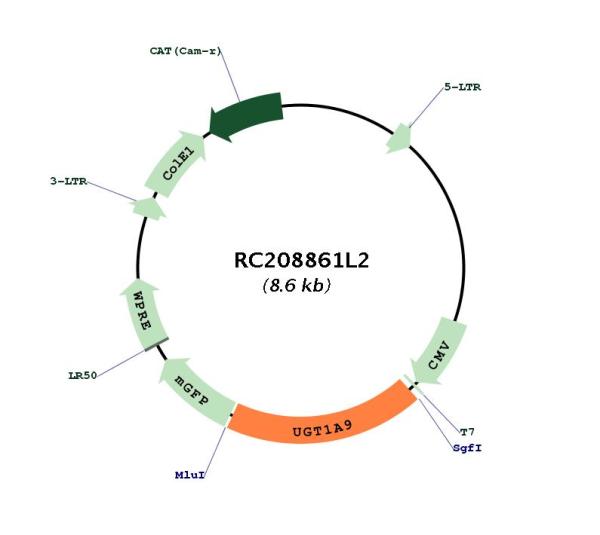UGT (UGT1A9) (NM_021027) Human Tagged Lenti ORF Clone
CAT#: RC208861L2
- LentiORF®
Lenti ORF clone of Human UDP glucuronosyltransferase 1 family, polypeptide A9 (UGT1A9), mGFP tagged
"NM_021027" in other vectors (6)
USD 365.00
USD 625.00
Specifications
| Product Data | |
| Type | Human Tagged ORF Clone |
| Tag | mGFP |
| Symbol | UGT |
| Synonyms | HLUGP4; LUGP4; UDPGT; UDPGT 1-9; UGT-1I; UGT1-09; UGT1-9; UGT1.9; UGT1A9S; UGT1AI; UGT1I |
| Vector | pLenti-C-mGFP |
| E. coli Selection | Chloramphenicol (34 ug/mL) |
| Mammalian Cell Selection | None |
| Sequence Data |
The ORF insert of this clone is exactly the same as(RC208861).
|
| Restriction Sites |
SgfI-MluI
Cloning Scheme for this gene
Plasmid Map

|
| ACCN | NM_021027 |
| ORF Size | 1590 bp |
| OTI Disclaimer | Due to the inherent nature of this plasmid, standard methods to replicate additional amounts of DNA in E. coli are highly likely to result in mutations and/or rearrangements. Therefore, OriGene does not guarantee the capability to replicate this plasmid DNA. Additional amounts of DNA can be purchased from OriGene with batch-specific, full-sequence verification at a reduced cost. Please contact our customer care team at custsupport@origene.com or by calling 301.340.3188 option 3 for pricing and delivery. The molecular sequence of this clone aligns with the gene accession number as a point of reference only. However, individual transcript sequences of the same gene can differ through naturally occurring variations (e.g. polymorphisms), each with its own valid existence. This clone is substantially in agreement with the reference, but a complete review of all prevailing variants is recommended prior to use. More info |
| OTI Annotation | This clone was engineered to express the complete ORF with an expression tag. Expression varies depending on the nature of the gene. |
| Product Components | The ORF clone is ion-exchange column purified and shipped in a 2D barcoded Matrix tube containing 10ug of transfection-ready, dried plasmid DNA (reconstitute with 100 ul of water). |
| Reconstitution | 1. Centrifuge at 5,000xg for 5min. 2. Carefully open the tube and add 100ul of sterile water to dissolve the DNA. 3. Close the tube and incubate for 10 minutes at room temperature. 4. Briefly vortex the tube and then do a quick spin (less than 5000xg) to concentrate the liquid at the bottom. 5. Store the suspended plasmid at -20°C. The DNA is stable for at least one year from date of shipping when stored at -20°C. |
| Reference Data | |
| RefSeq | NM_021027.2 |
| RefSeq Size | 2395 bp |
| RefSeq ORF | 1593 bp |
| Locus ID | 54600 |
| UniProt ID | O60656 |
| Cytogenetics | 2q37.1 |
| Domains | UDPGT |
| Protein Families | Druggable Genome, Transmembrane |
| Protein Pathways | Androgen and estrogen metabolism, Ascorbate and aldarate metabolism, Drug metabolism - cytochrome P450, Drug metabolism - other enzymes, Metabolic pathways, Metabolism of xenobiotics by cytochrome P450, Pentose and glucuronate interconversions, Porphyrin and chlorophyll metabolism, Retinol metabolism, Starch and sucrose metabolism |
| MW | 59.9 kDa |
| Gene Summary | This gene encodes a UDP-glucuronosyltransferase, an enzyme of the glucuronidation pathway that transforms small lipophilic molecules, such as steroids, bilirubin, hormones, and drugs, into water-soluble, excretable metabolites. This gene is part of a complex locus that encodes several UDP-glucuronosyltransferases. The locus includes thirteen unique alternate first exons followed by four common exons. Four of the alternate first exons are considered pseudogenes. Each of the remaining nine 5' exons may be spliced to the four common exons, resulting in nine proteins with different N-termini and identical C-termini. Each first exon encodes the substrate binding site, and is regulated by its own promoter. The enzyme encoded by this gene is active on phenols. [provided by RefSeq, Jul 2008] |
Documents
| Product Manuals |
| FAQs |
| SDS |
Resources
Other Versions
| SKU | Description | Size | Price |
|---|---|---|---|
| RC208861 | UGT1A9 (Myc-DDK-tagged)-Human UDP glucuronosyltransferase 1 family, polypeptide A9 (UGT1A9) |
USD 740.00 |
|
| RC208861L1 | Lenti ORF clone of Human UDP glucuronosyltransferase 1 family, polypeptide A9 (UGT1A9), Myc-DDK-tagged |
USD 1,040.00 |
|
| RC208861L3 | Lenti ORF clone of Human UDP glucuronosyltransferase 1 family, polypeptide A9 (UGT1A9), Myc-DDK-tagged |
USD 1,040.00 |
|
| RC208861L4 | Lenti ORF clone of Human UDP glucuronosyltransferase 1 family, polypeptide A9 (UGT1A9), mGFP tagged |
USD 1,040.00 |
|
| RG208861 | UGT1A9 (tGFP-tagged) - Human UDP glucuronosyltransferase 1 family, polypeptide A9 (UGT1A9) |
USD 940.00 |
|
| SC113006 | UGT1A9 (untagged)-Human UDP glucuronosyltransferase 1 family, polypeptide A9 (UGT1A9) |
USD 741.00 |
{0} Product Review(s)
Be the first one to submit a review






























































































































































































































































 Germany
Germany
 Japan
Japan
 United Kingdom
United Kingdom
 China
China

